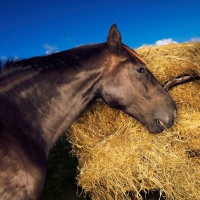Horses are herbivores

Horses are large grass eating animals, herbivores, and free-living horses graze 14-18 hours of the day. The horse relies on hindgut fermentation which means that its caecum and colon is inhabited by microorganisms (bacteria, protozoa and fungi) that degrades fibre. The rest products of the microorganisms are short-chain fatty acids that are absorbed and utilised by the horse as energy and without its extensive microflora the horse would not be able to feed on grass. With a diet consisting of mainly forage or only forage the short-chain fatty acids are the horse’s largest energy source.
However, the microbial flora inhabits the entire equine gastrointestinal tract, high counts of total anaerobic bacteria has been found throughout the digestive tract and even in higher numbers in the stomach than the small intestine. Concentrations of the fibre-degrading bacteria, as cellulolytic bacteria, are high in the hindgut and low in the stomach and small intestine which shows that fibre degradation takes place in the hindgut. The horse’s diet has an impact on the composition of the microflora and therefore also which types of short-chain fatty acids that are produced. A diet consisting of mainly forage or only forage results in higher acetate concentrations and lower propionate concentrations. Acetate is a weaker acid than propionate and therefore it does not decrease pH as much (pH = measure of acidity). High intakes of starchy concentrate results in high production of propionate but also lactate and can lead to a rapid decrease in pH and highly increased risk of intestinal disturbances and colic.
The hindgut of the horse also functions as a large fluid reservoir. This is possible because fibre binds water. Fibre has high water-holding capacity and a high forage diet provides a lot of fibre for the horse and therefore also a larger fluid reservoir than a low forage:high concentrate diet. High performing horses can have large fluid losses during intensive exercise and a high forage diet seems to be an advantage for the fluid balance of the horse.
Because horses are herbivores there is nothing that can replace high quality forage when it comes to horses’ gut health and wellbeing.
Sara Muhonen, AgrD
